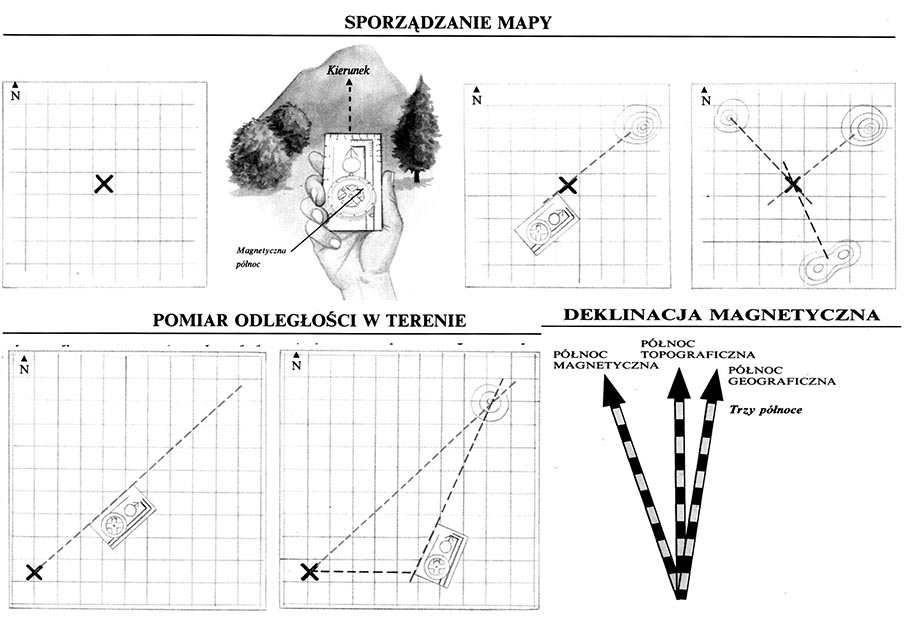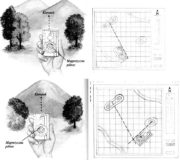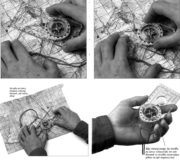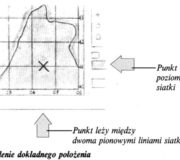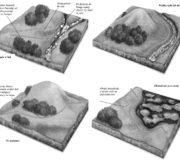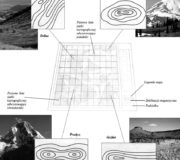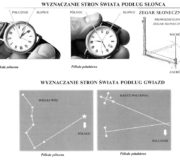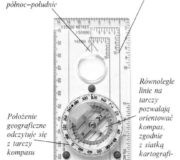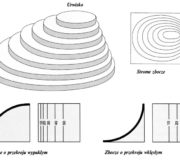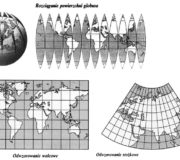1 Na kartce papieru wykreśl prostokątną siatkę o oczkach odpowiadających jednemu kilometrowi kwadratowemu powierzchni terenu. Na środku narysuj krzyżyk oznaczający Twoją pozycję.
2 Znajdź dogodny punkt obserwacyjny. Wyznacz kompasem azymut, określający kierunek charakterystycznego punktu na horyzoncie. Oszacuj odległość od tego punktu (patrz niżej).
3 Zorientuj siatkę mapy zgodnie z osią północ-południe i narysuj linię biegnącą od krzyżyka, według azymutu. Na linii zaznacz wzgórze.
4 Tak samo ustal położenie dwóch innych obiektów, widocznych z miejsca, w którym się znajdujesz. Twoją pozycję na mapie powinien wyznaczać punkt przecięcia wychodzących od nich linii.
POMIAR ODLEGŁOŚCI W TERENIE
Aby wyznaczyć położenie danego obiektu na planie, musisz najpierw oszacować jego odległość od miejsca, w którym się znajdujesz. Możesz to zrobić wyznaczając azymut. Najpierw ustal kierunek, w którym znajduje się obiekt. Potem przenieś się do drugiego miejsca, które potrafisz zaznaczyć na mapie. Odległość między nimi możesz zmierzyć krokami. Po określeniu kierunku obiektu z drugiego miejsca należy wykreślić na mapie linie biegnące z obu punktów, według azymutu. W miejscu ich przecięcia można narysować symbol obiektu. Teraz za pomocą siatki łatwo obliczysz jego odległość od miejsca, w którym się znajdujesz.
1 Przedstawiona metoda pozwala zmierzyć odległość od dowolnego obiektu w terenie zarówno posługując się gotową mapą, jak i własnoręcznie wykreślonym planem. Przy wykreślaniu własnego planu należy zwrócić uwagę, by wszystkie oczka prostokątnej siatki były jednakowe. Najpierw trzeba wyznaczyć azymut do wybranego obiektu, na przykład wzgórza. Potem narysować linię biegnącą od krzyżyka (obserwatora) w kierunku obiektu, zgodnie z azymutem.
2 Należy przejść określoną odległość obierając azymut 90° względem kierunku północnego, aż osiągnie się punkt, w którym azymut do obiektu będzie się różnił przynajmniej o 30° od zmierzonego poprzednio. Należy zaznaczyć tę pozycję na mapie i wyznaczyć azymut oraz określić go linią na mapie. Wzgórze znajduje się na przecięciu obu linii. Teraz można oszacować jego odległość licząc linie prostokątnej siatki.
DEKLINACJA MAGNETYCZNA
Przy wyznaczaniu kierunków oraz określaniu azymutów popełniamy błąd związany z istnieniem trzech różnych kierunków północnych – północy magnetycznej, północy na mapie i północy rzeczywistej, czyli geograficznej. Kąt między kierunkiem północnym a kierunkiem, który wskazuje koniec igły magnetycznej nazywany jest deklinacją lub zboczeniem magnetycznym; wiąże się z różnicą w położeniu biegunów magnetycznego i ziemskiego. Na dużych szerokościach geograficznych znacznie ona wzrasta, a w krajach polarnych może całkowicie wykluczać posługiwanie się igłą magnetyczną dla orientacji w terenie. Dlatego należy znać deklinację magnetyczną występującą na danym obszarze. Jeśli jest znaczna, trzeba ją dodać lub odjąć od zmierzonego kompasem azymutu. Na wielu mapach deklinacja magnetyczna jest oznaczona w legendzie trzema strzałkami.
Trzy północe – Północ magnetyczna to północ wskazywana przez igłę kompasu; topograficzna – wyznaczona przez siatkę mapy, północ właściwa zaś to kierunek, w którym rzeczywiście znajduje się północny biegun ziemski. Deklinacja magnetyczna to kąt między kierunkiem wskazywanym przez igłę magnetyczną a północą na mapie.
PRAKTYCZNE WSKAZÓWKI
■ Złota zasada brzmi: „ufaj kompasowi”. Wielu ludzi gubi się dlatego, że bardziej wierzy własnej, złudnej orientacji niż wskazaniom igły magnetycznej.
■ Zawsze wyznaczaj azymuty i odległości według własnej pozycji.
■ Staraj się prawidłowo rozpoznać ukształtowanie terenu, przebieg dolin i grzbietów górskich.
■ Zorientuj mapę posługując się kompasem. Potem nanieś na nią widoczne, ważniejsze elementy krajobrazu, a przed wyruszeniem ustal kierunek marszu oraz obierz właściwy azymut.
